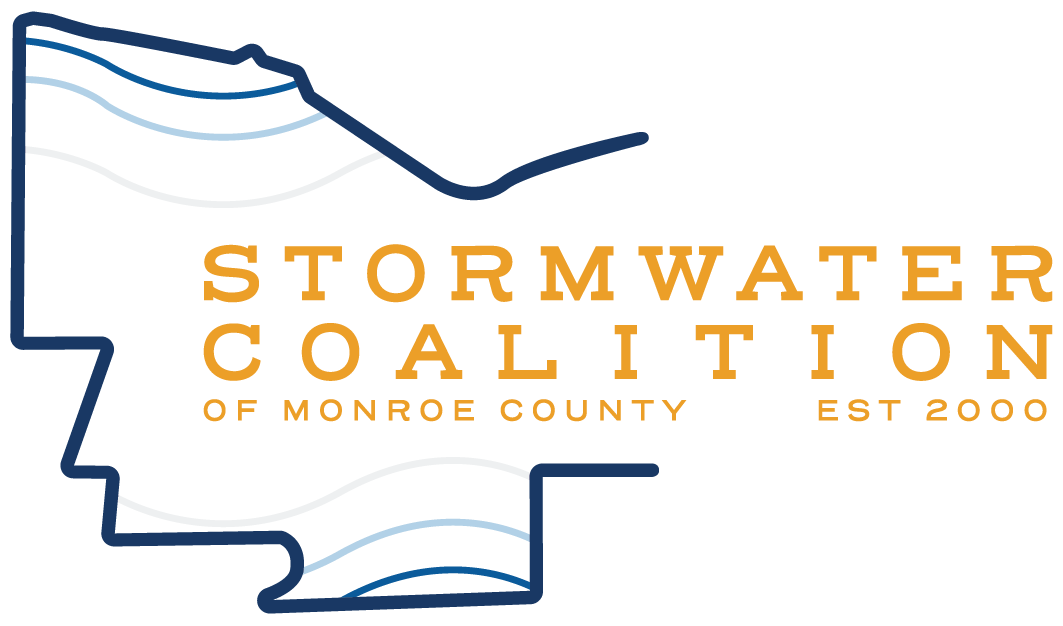Stormwater Ponds
Stormwater ponds improve water quality, reduce pollution and prevent flooding.
Photo of Durand Eastman Park, Irondequoit.
Common Misconceptions
Myth: Cattails and other vegetation make ponds unattractive and contribute to their deterioration.
Reality: Cattails and other vegetation stabilize shorelines, reduce nutrient loads and provide important wildlife habitat.
Myth: Healthy ponds host large populations of ducks and geese.
Reality: Ponds with high populations of waterfowl usually have high levels of pollution from their waste.
Myth: Dumping trash and used oil down storm drains is okay because it will go to the water treatment plant.
Reality: Most storm drains empty in to your neighborhood stream or pond.
Myth: Stormwater ponds are eyesores that require constant maintenance.
Reality: Stormwater ponds are designed to clean stormwater and decrease costly downstream flooding and stream bank erosion.
Myth: Stormwater ponds are breeding grounds for disease-causing mosquitoes.
Reality: Mosquitoes breed in pools of stagnant water. Correctly designed stormwater ponds are designed to minimize stagnant water. Disease causing mosquitoes are more commonly found in stagnant water sources near homes such as: clogged roof gutters, wheelbarrows, old tires, flowerpots, and bird baths
Well Maintained
Stormwater management ponds with natural vegetation, reduces waterfowl and helps to clean stormwater.
Photo of Durand Eastman Park, Irondequoit.
Poorly Maintained
Keep stormwater management ponds functional by keeping them free of litter, grass clippings and fertilizer that create excessive algae.
Photo of Shipbuilders Creek, Webster.

Common Problems
Algae Blooms
Fertilizers, grass clippings, and pet waste contain nutrients such as nitrogen and phosphorous that increase algae growth. Shallow water warmed by the sun can lead to algae growth.
Cause
Excessive nutrients such as nitrogen and phosphorous and direct sunlight can cause rapid growth of algae.
Prevention
Reduce or eliminate the use of fertilizer products on lawn.
Use of barley straw can reduce algae growth.
Prevent grass cuttings from entering pond.
Reduce or eliminate waterfowl and/or pet waste from entering water.
Solution
Reduce the amount of nutrients entering the pond i.e. stormwater runoff containing pesticides and fertilizers from lawn areas and farmland.
Erosion & Siltation
Water flowing over bare soil transports soil directly into ponds and causes erosion and water pollution.
Cause
The action of water falling on or running over bare soil displaces sediment.
Prevention
Avoid destroying natural vegetation (shrubs & grasses) near the water’s edge.
Seed and mulch any exposed soils.
Reduce areas with steep slopes around stormwater ponds.
Solution
Plant vegetation and mulch to cover bare soil and help reduce soil erosion.
When vegetative measures are not adequate, place fieldstone or rip-rap near the waterline with municipal approval.
Human Pollution
Most storm drains discharge directly into ponds or nearby streams and carry chemicals, soap, litter etc. from the land directly to the water without being treated.
Cause
Dumping chemicals such as oil, paint, gas and litter on to land, or storm drains that empty into the pond.
Prevention
Don’t dump anything into storm drains
Wash vehicles on lawn not driveway or take to car wash to prevent soap from entering waterways.
Properly dispose of chemicals and litter.
Solution
Marking or stenciling storm drains reminds people not to put anything into storm drains. Call (585) 753-7600 x3 to contact the Household Hazardous Waste Facility to dispose of chemicals.
Non-Native Invasive
Aquatic Species
Species not native to the ecosystem such as zebra mussels can cause environmental and economic harm by altering habitats for plants and animals and clogging water intake and discharge pipes.
Cause
The introduction of nonnative species to the pond by humans and migrating waterfowl.
Prevention
Never dump water, plants, fish or animals in to a body of water unless they came out of that body of water.
Solution
Physically remove non-native species before they become more well-established. See the NYS DEC website for more information.
Plant native species.
Nuisance Rodents
Muskrats and other rodents burrow into banks causing erosion and dam failures. Beavers can cause flooding issues.
Cause
Muskrats and other rodents inhabit banks and disturb plant materials which may cause banks to erode or impair function of pond.
Prevention
Monitor pond for evidence of destructive wildlife
Place stone several feet above and below the waterline to prevent burrowing—Must get municipal approval first
Solution
For nuisance beaver and muskrats Contact the NYS Dept. of Environmental Conservation office for permits and control methods.
Nuisance Waterfowl
Canada Geese prefer to be able to enter and exit water where there is limited vegetation for their predators to hide. Mowing to the edge of a pond creates ideal habitat for geese.
Cause
Mowing vegetation up to the edge of the water creates desirable habitat for Canada Geese. Feeding of waterfowl.
Prevention
Don’t mow grass to the edge of the pond.
Allow natural vegetation (shrubs and grasses only) to grow 3-5 ft. from the edge of the pond, this allows for a natural buffer
Avoid feeding waterfowl.
Install a physical barrier close to the water’s edge such as wire fence or bird netting.
Solution
No single technique to discourage geese is always effective or acceptable. The persistent application of a combination of methods is usually necessary to yield the desired results.
For Nuisance Canada Goose problems and permits check out the NYS DEC website.









